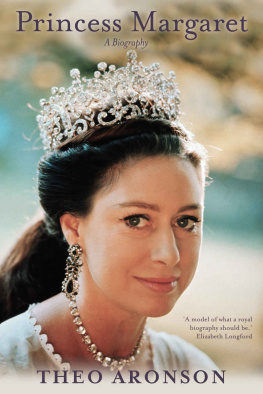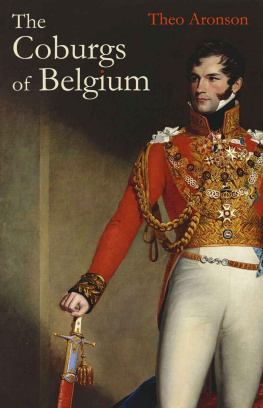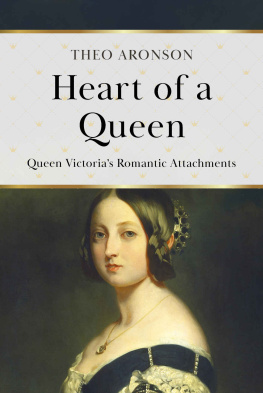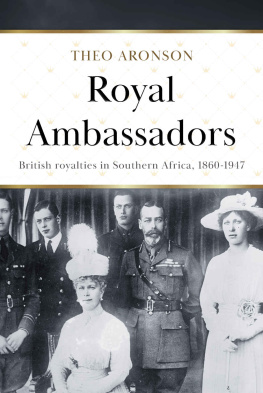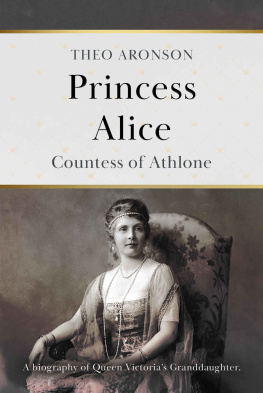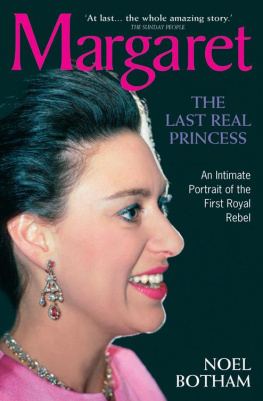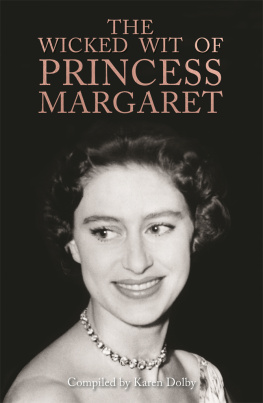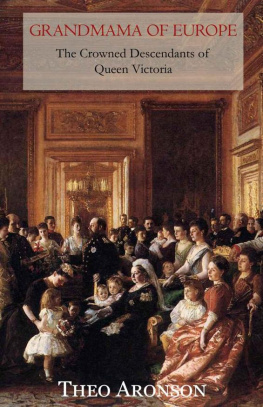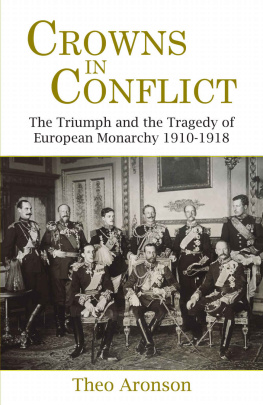Aronson Theo - Princess Margaret: a biography
Here you can read online Aronson Theo - Princess Margaret: a biography full text of the book (entire story) in english for free. Download pdf and epub, get meaning, cover and reviews about this ebook. City: London;Great Britain, year: 2001;2013, publisher: Thistle Publishing;Michael OMara, genre: Non-fiction. Description of the work, (preface) as well as reviews are available. Best literature library LitArk.com created for fans of good reading and offers a wide selection of genres:
Romance novel
Science fiction
Adventure
Detective
Science
History
Home and family
Prose
Art
Politics
Computer
Non-fiction
Religion
Business
Children
Humor
Choose a favorite category and find really read worthwhile books. Enjoy immersion in the world of imagination, feel the emotions of the characters or learn something new for yourself, make an fascinating discovery.
- Book:Princess Margaret: a biography
- Author:
- Publisher:Thistle Publishing;Michael OMara
- Genre:
- Year:2001;2013
- City:London;Great Britain
- Rating:5 / 5
- Favourites:Add to favourites
- Your mark:
- 100
- 1
- 2
- 3
- 4
- 5
Princess Margaret: a biography: summary, description and annotation
We offer to read an annotation, description, summary or preface (depends on what the author of the book "Princess Margaret: a biography" wrote himself). If you haven't found the necessary information about the book — write in the comments, we will try to find it.
Princess Margaret: a biography — read online for free the complete book (whole text) full work
Below is the text of the book, divided by pages. System saving the place of the last page read, allows you to conveniently read the book "Princess Margaret: a biography" online for free, without having to search again every time where you left off. Put a bookmark, and you can go to the page where you finished reading at any time.
Font size:
Interval:
Bookmark:
Princess Margaret
A Biography
Theo Aronson
Copyright 2013, Theo Aronson
All Rights Reserved
This edition published in 2013 by: Theo Aronson
Thistle Publishing
36 Great Smith Street
London
SW1P 3BU
A lthough this book is in no way authorized or sanctioned, my chief thanks are to its subject, Princess Margaret. For two of my previous books, Royal Family: Years of Transition and The Royal Family at War, the Princess has very kindly received me in order to give me her memories, observations and opinions, many of which I have been able to incorporate in this study. I am grateful to Her Royal Highness for her help and hospitality.
Other members of the royal family who have very kindly and on several occasions received me to share their thoughts of the years covered by the span of this book are Queen Elizabeth the Queen Mother, the Prince of Wales, Princess Alice, Duchess of Gloucester and the late Princess Alice, Countess of Athlone.
I am also indebted to members of the various royal households who, to a greater or lesser extent, have given me information and assistance during my research into the recent history of the royal family. Although none of them has been specifically consulted for this book, their contributions have helped me come to a greater understanding of life in the royal households.
This biography has depended, to a considerable extent, on oral evidence. Much of this has been given to me in confidence and, for obvious reasons, I have respected the wishes of those many people who have asked to remain anonymous. I am extremely grateful to them for their co-operation. Others who have very kindly helped me in various ways are, in alphabetical order, Harold Ashwell, the late Stella, Lady Bailey, Toby Barker, Stephen Birmingham, Miriam Bloomberg, Michael Bott, Andr Bothner, Mervyn Clingan, Aedwyn Darroll, Phyllis Dent-Watson, Jayne Fincher, Lady Grahame, David Griffiths, the late Dowager Viscountess Hambleden, the Earl of Harewood, the late Joan Lascelles, Andrew Lownie, Alan Scales, Peter Scott-Thompson, Yvone Sterenborg, the late Group Captain Peter Townsend, Hugo Vickers, Denise Wakeford, the late Jock Webster.
I am grateful to the staffs of the British Library, the Newspaper Library at Colindale, the University of Reading Archives, the Bristol Reference Library, the Bath Reference Library and, not least, the Frome Library. I am indebted to the authors and publishers of all the books listed in my Bibliography, especially to those of all previous biographies of Princess Margaret. Three books which have proved especially useful are, in order of publication, HRH The Princess Margaret by Nigel Dempster, Princess Margaret, Countess of Snowdon by Christopher Warwick, and Margaret: The Untold Story by Noel Botham.
As always, my chief thanks are to Brian Roberts for his unfailing help and encouragement.
P rincess Margaret remains, in many ways, the most interesting member of the British royal family. Part imperious royal figure, part femme du monde, she is quite different from the rest of them. She is more sophisticated, more outr. Everything the lavish hats, the long cigarette holder, the drawling voice, the brightly lipsticked mouth, the artfully dyed hair, the frequently replenished whisky glass, the high heels reinforces the image of a raffish divorce. Through a family that has often been accused of being too county and conventional, she has swept like a breath of, if not exactly fresh, then certainly scented, air.
The Princess has been described as a law unto herself. Unlike her conscientious sister, Queen Elizabeth II, she will blithely miss important family occasions. She carries out her official engagements in a perfunctory fashion, showing very little of the charm and enthusiasm of the Queen Mother. While her nephews ex-wives, the Princess of Wales and the Duchess of York, have shamelessly courted the attention of the media, Princess Margaret has treated it with disdain. She has never, unlike her niece Princess Anne, won public acclaim by dedicating herself to some newsworthy charitable cause.
Her style of life has been unorthodox. While the rest of her family move in an unvarying routine between Windsor, Sandringham and Balmoral, she will be sunning herself in Italy, Turkey or the Caribbean. She has none of the horsey, frankly philistine, tastes of so many members of the royal family. Her interests are more worldly; she enjoys travel, ballet, music, the theatre, parties. Seeing herself as something of a bohemian, she has moved in risque circles, leading what the disapproving Queen calls a guttersnipe life.
Yet she remains dauntingly royal. Princess Margaret is very conscious of the fact that she is the daughter of a king, the sister of a queen. In her youth, only one life stood between her and the succession to the British throne. Her imperiousness is legendary. Any show of over-familiarity, any hint of lse-majest, will be met by an icy stare. Dare to say your sister instead of the Queen and she will cut you dead. Even her friends are obliged to address her as Maam or, if especially close, as Maam darling. Those who do not know her well find themselves bewildered by her approachability at one moment, her royal hauteur the next.
Her behaviour and attitudes can be astonishingly high-handed. When faced with a bore, she will cut short the conversation with a sharply expressed Quite and turn her back. On one occasion, when discussing the abolition of the royal presentation parties at which the Seasons debutantes would be presented to the monarch, and which, in the more egalitarian atmosphere of post-Second World War Britain, had become an anachronism, she made a wonderfully idiosyncratic remark. We had to stop them, she explained. Every tart in London was being presented. In other words, the presentation parties had not been abolished because they had become too exclusive but because they were no longer exclusive enough.
This duality in her nature, this pull between being a rebel and being royal, is compounded by the awkwardness of her status. What, exactly, is a princess supposed to do in the second half of the twentieth century? She was born into an almost Victorian world of pomp, privilege and deference. Governess-educated, cocooned, indulged, she was never expected to do much more than look attractive and act graciously. In some ways, she is like an exile from another era, the last real princess.
Princess Margaret has been variously described as tragic, unresolved, a royal maverick, a woman of conflict, a princess without a cause. And although she is neither the unhappy figure of some imaginings nor the spoiled brat of others, she has been her own worst
But it was not quite as simple as that.
P rincess Margaret was born, appropriately enough, during a violent thunderstorm. Equally dramatic was the setting for her birth: Glamis Castle, ancestral home of the Earls of Strathmore and Kinghorne. Her mother, the Duchess of York, had been born Lady Elizabeth Bowes-Lyon, the ninth child of the fourteenth Earl of Strathmore, and it was to her familys Scottish seat, Glamis Castle on Tayside, that the Duchess of York had come to give birth to her second child in the late summer of 1930.
With its turrets, battlements and impregnable red sandstone walls, Glamis is an impressive pile, both romantic and menacing. In its time it has played host to such significant historical figures as Mary, Queen of Scots, James Stuart, the Old Pretender, and Sir Walter Scott. It is for its more blood-curdling associations, however, that Glamis is chiefly remarkable. Its story is one of violent deaths, gruesome murders and terrifying ghosts. Macbeth is said to have slain Duncan in the guardroom: Glamis hath murdered sleep, and therefore Macbeth shall sleep no more! ring Shakespeares lines. The castle has witnessed other equally grim, and better authenticated, deaths. King Malcolms Room is where the murdered King Malcolm II of Scotland died; its floor is still stained, it is claimed, with his blood. The Hangmans Chamber takes its name from the two desperate men who had hanged themselves within its dank walls. In the Room of Skulls captured members of the Ogilvy family, bitter enemies of the Lyons, were walled up alive and, despite gnawing at their own flesh, finally died of starvation, their corpses rotting away into a pile of bones.
Next pageFont size:
Interval:
Bookmark:
Similar books «Princess Margaret: a biography»
Look at similar books to Princess Margaret: a biography. We have selected literature similar in name and meaning in the hope of providing readers with more options to find new, interesting, not yet read works.
Discussion, reviews of the book Princess Margaret: a biography and just readers' own opinions. Leave your comments, write what you think about the work, its meaning or the main characters. Specify what exactly you liked and what you didn't like, and why you think so.

